Managing Finance and Financial Decisions: Madoff's Fraud and SEC Role
VerifiedAdded on 2021/06/17
|10
|2467
|18
Report
AI Summary
This report provides a comprehensive analysis of the Bernie Madoff Ponzi scheme, detailing its operational mechanisms, the circumstances surrounding its eventual exposure, and the role of the U.S. Securities and Exchange Commission (SEC). It examines the allegations against the SEC, highlighting its failures to act on early warnings and conduct thorough investigations, and compares the consequences faced by Madoff with the repercussions for SEC employees. The report explores the fraudulent investment strategy employed by Madoff, which promised unusually high returns, and the panic during the 2008 financial crisis that triggered investor redemption requests. It discusses the SEC's mission, the accusations of negligence, and the agency's reliance on falsified information. Furthermore, it outlines the legal and disciplinary actions taken against Madoff and some SEC employees, concluding that the punishments for SEC staff were far less severe than the consequences for Madoff. The report uses multiple sources to support its claims and draws conclusions about the failures of financial oversight and the impact of the fraud.
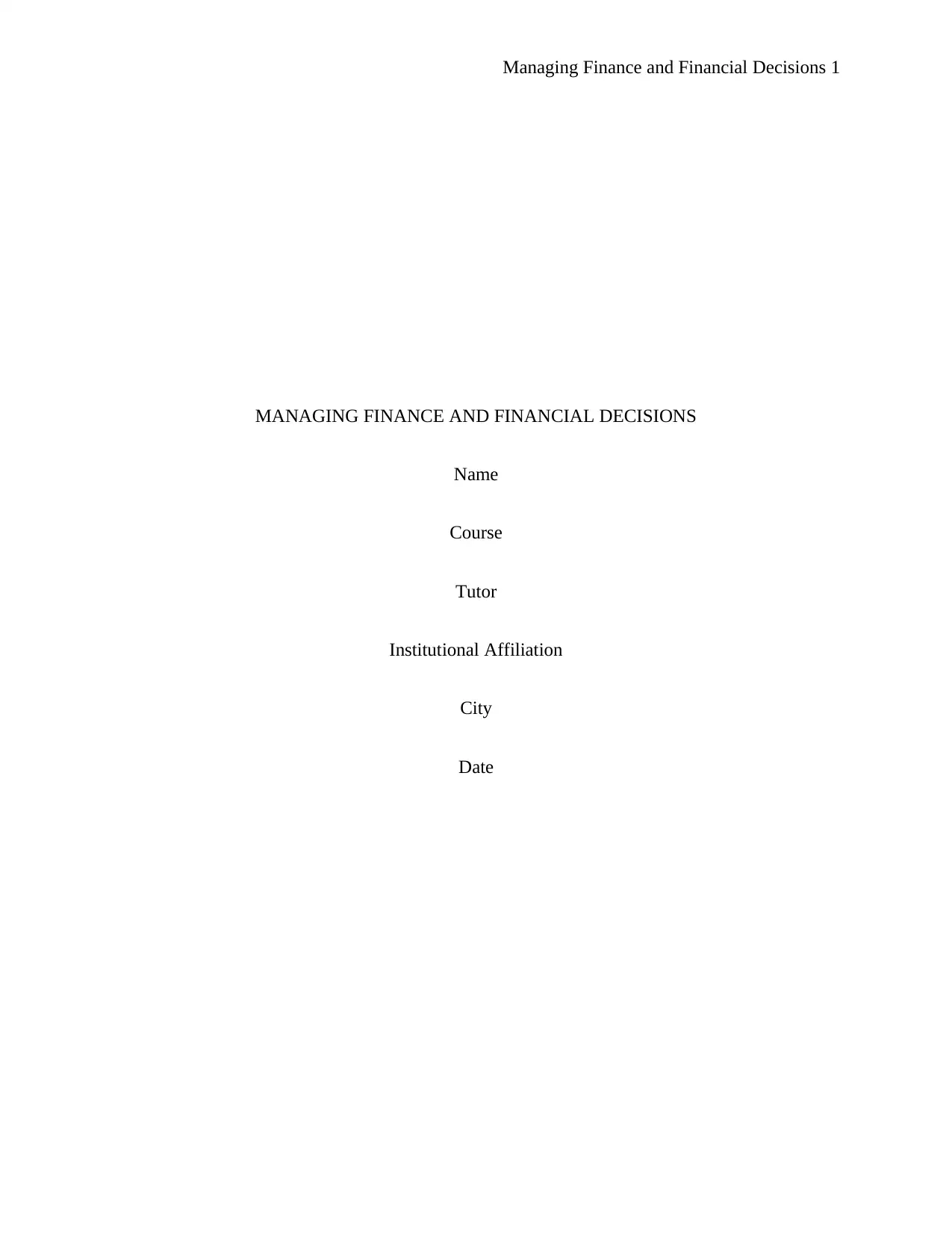
Managing Finance and Financial Decisions 1
MANAGING FINANCE AND FINANCIAL DECISIONS
Name
Course
Tutor
Institutional Affiliation
City
Date
MANAGING FINANCE AND FINANCIAL DECISIONS
Name
Course
Tutor
Institutional Affiliation
City
Date
Paraphrase This Document
Need a fresh take? Get an instant paraphrase of this document with our AI Paraphraser
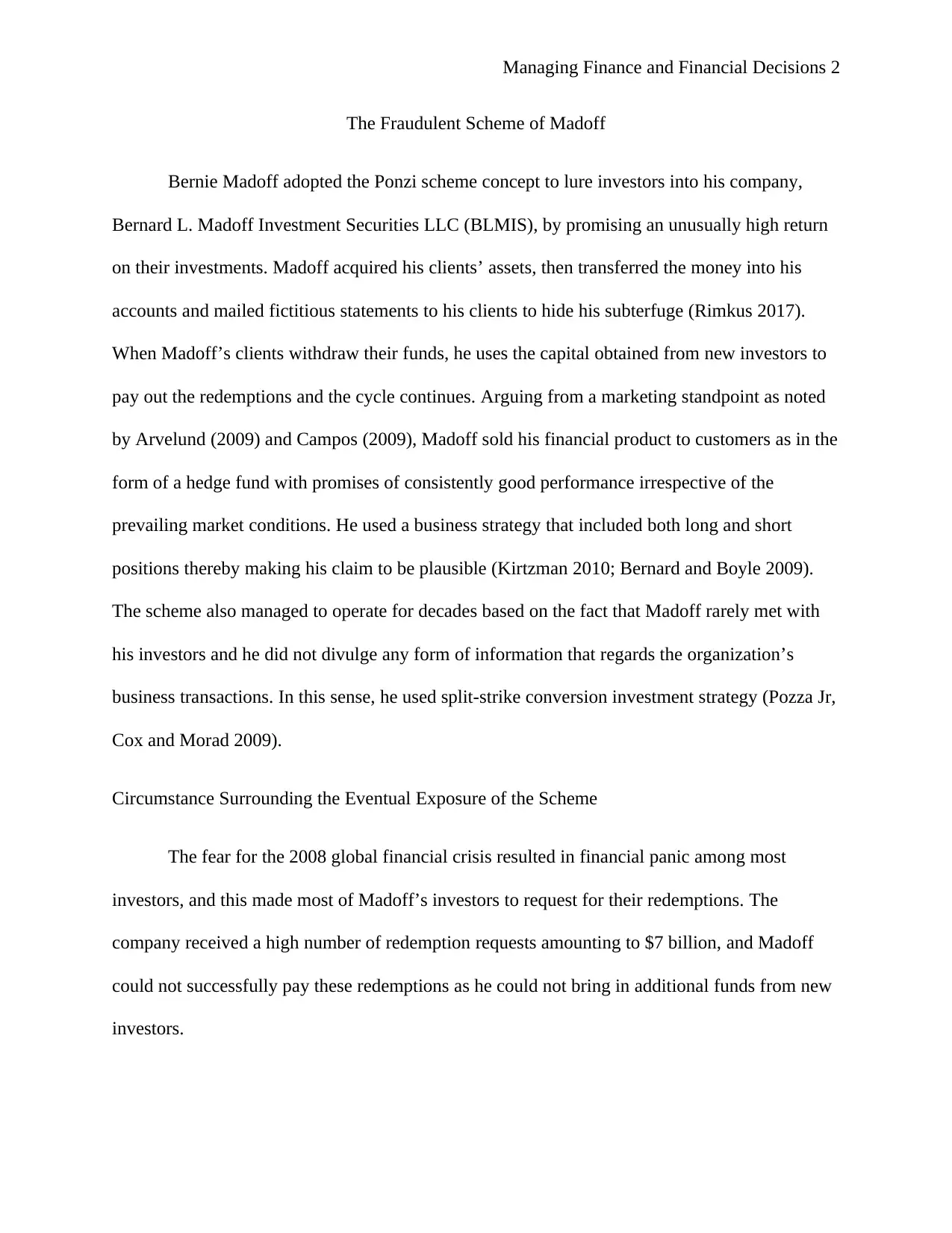
Managing Finance and Financial Decisions 2
The Fraudulent Scheme of Madoff
Bernie Madoff adopted the Ponzi scheme concept to lure investors into his company,
Bernard L. Madoff Investment Securities LLC (BLMIS), by promising an unusually high return
on their investments. Madoff acquired his clients’ assets, then transferred the money into his
accounts and mailed fictitious statements to his clients to hide his subterfuge (Rimkus 2017).
When Madoff’s clients withdraw their funds, he uses the capital obtained from new investors to
pay out the redemptions and the cycle continues. Arguing from a marketing standpoint as noted
by Arvelund (2009) and Campos (2009), Madoff sold his financial product to customers as in the
form of a hedge fund with promises of consistently good performance irrespective of the
prevailing market conditions. He used a business strategy that included both long and short
positions thereby making his claim to be plausible (Kirtzman 2010; Bernard and Boyle 2009).
The scheme also managed to operate for decades based on the fact that Madoff rarely met with
his investors and he did not divulge any form of information that regards the organization’s
business transactions. In this sense, he used split-strike conversion investment strategy (Pozza Jr,
Cox and Morad 2009).
Circumstance Surrounding the Eventual Exposure of the Scheme
The fear for the 2008 global financial crisis resulted in financial panic among most
investors, and this made most of Madoff’s investors to request for their redemptions. The
company received a high number of redemption requests amounting to $7 billion, and Madoff
could not successfully pay these redemptions as he could not bring in additional funds from new
investors.
The Fraudulent Scheme of Madoff
Bernie Madoff adopted the Ponzi scheme concept to lure investors into his company,
Bernard L. Madoff Investment Securities LLC (BLMIS), by promising an unusually high return
on their investments. Madoff acquired his clients’ assets, then transferred the money into his
accounts and mailed fictitious statements to his clients to hide his subterfuge (Rimkus 2017).
When Madoff’s clients withdraw their funds, he uses the capital obtained from new investors to
pay out the redemptions and the cycle continues. Arguing from a marketing standpoint as noted
by Arvelund (2009) and Campos (2009), Madoff sold his financial product to customers as in the
form of a hedge fund with promises of consistently good performance irrespective of the
prevailing market conditions. He used a business strategy that included both long and short
positions thereby making his claim to be plausible (Kirtzman 2010; Bernard and Boyle 2009).
The scheme also managed to operate for decades based on the fact that Madoff rarely met with
his investors and he did not divulge any form of information that regards the organization’s
business transactions. In this sense, he used split-strike conversion investment strategy (Pozza Jr,
Cox and Morad 2009).
Circumstance Surrounding the Eventual Exposure of the Scheme
The fear for the 2008 global financial crisis resulted in financial panic among most
investors, and this made most of Madoff’s investors to request for their redemptions. The
company received a high number of redemption requests amounting to $7 billion, and Madoff
could not successfully pay these redemptions as he could not bring in additional funds from new
investors.
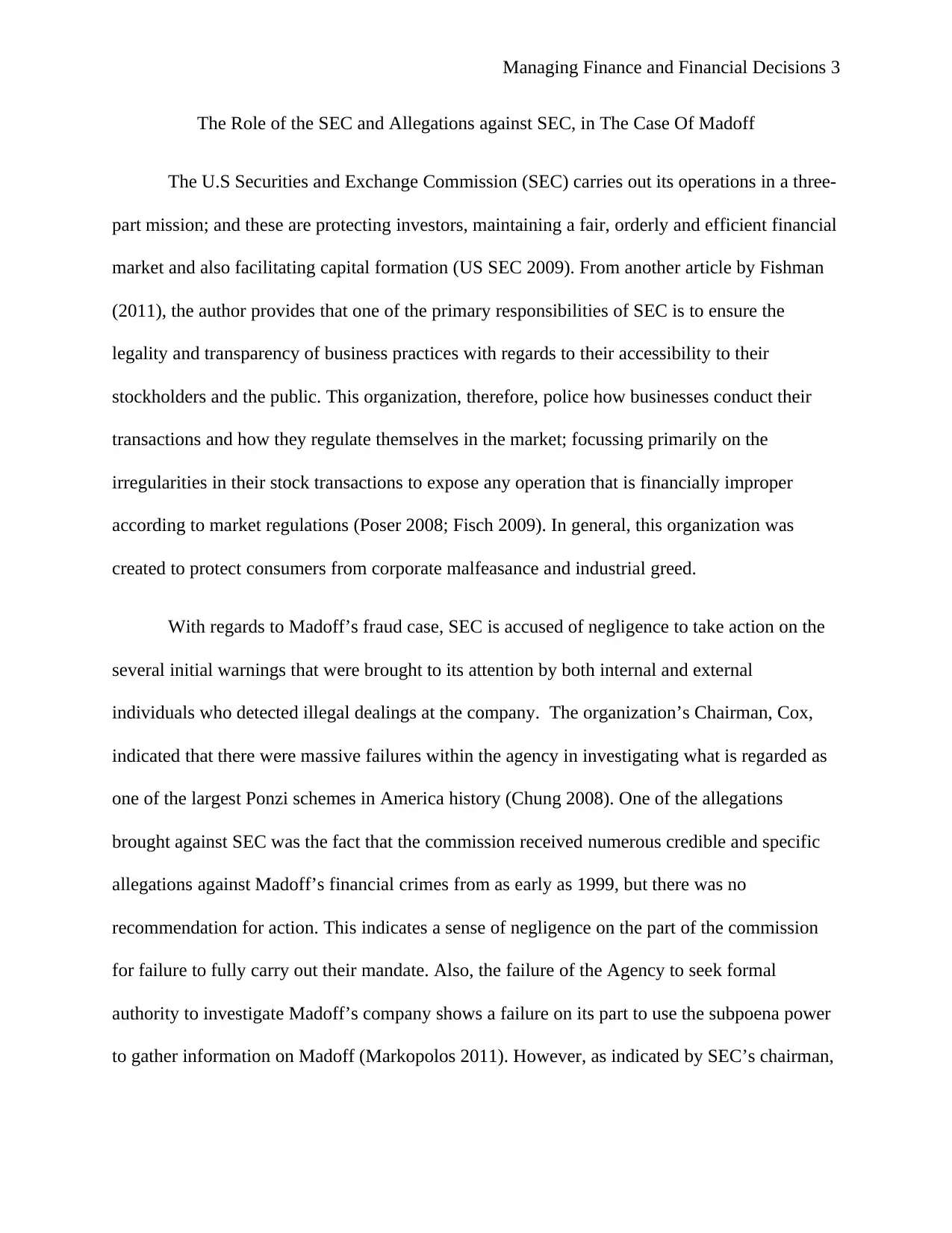
Managing Finance and Financial Decisions 3
The Role of the SEC and Allegations against SEC, in The Case Of Madoff
The U.S Securities and Exchange Commission (SEC) carries out its operations in a three-
part mission; and these are protecting investors, maintaining a fair, orderly and efficient financial
market and also facilitating capital formation (US SEC 2009). From another article by Fishman
(2011), the author provides that one of the primary responsibilities of SEC is to ensure the
legality and transparency of business practices with regards to their accessibility to their
stockholders and the public. This organization, therefore, police how businesses conduct their
transactions and how they regulate themselves in the market; focussing primarily on the
irregularities in their stock transactions to expose any operation that is financially improper
according to market regulations (Poser 2008; Fisch 2009). In general, this organization was
created to protect consumers from corporate malfeasance and industrial greed.
With regards to Madoff’s fraud case, SEC is accused of negligence to take action on the
several initial warnings that were brought to its attention by both internal and external
individuals who detected illegal dealings at the company. The organization’s Chairman, Cox,
indicated that there were massive failures within the agency in investigating what is regarded as
one of the largest Ponzi schemes in America history (Chung 2008). One of the allegations
brought against SEC was the fact that the commission received numerous credible and specific
allegations against Madoff’s financial crimes from as early as 1999, but there was no
recommendation for action. This indicates a sense of negligence on the part of the commission
for failure to fully carry out their mandate. Also, the failure of the Agency to seek formal
authority to investigate Madoff’s company shows a failure on its part to use the subpoena power
to gather information on Madoff (Markopolos 2011). However, as indicated by SEC’s chairman,
The Role of the SEC and Allegations against SEC, in The Case Of Madoff
The U.S Securities and Exchange Commission (SEC) carries out its operations in a three-
part mission; and these are protecting investors, maintaining a fair, orderly and efficient financial
market and also facilitating capital formation (US SEC 2009). From another article by Fishman
(2011), the author provides that one of the primary responsibilities of SEC is to ensure the
legality and transparency of business practices with regards to their accessibility to their
stockholders and the public. This organization, therefore, police how businesses conduct their
transactions and how they regulate themselves in the market; focussing primarily on the
irregularities in their stock transactions to expose any operation that is financially improper
according to market regulations (Poser 2008; Fisch 2009). In general, this organization was
created to protect consumers from corporate malfeasance and industrial greed.
With regards to Madoff’s fraud case, SEC is accused of negligence to take action on the
several initial warnings that were brought to its attention by both internal and external
individuals who detected illegal dealings at the company. The organization’s Chairman, Cox,
indicated that there were massive failures within the agency in investigating what is regarded as
one of the largest Ponzi schemes in America history (Chung 2008). One of the allegations
brought against SEC was the fact that the commission received numerous credible and specific
allegations against Madoff’s financial crimes from as early as 1999, but there was no
recommendation for action. This indicates a sense of negligence on the part of the commission
for failure to fully carry out their mandate. Also, the failure of the Agency to seek formal
authority to investigate Madoff’s company shows a failure on its part to use the subpoena power
to gather information on Madoff (Markopolos 2011). However, as indicated by SEC’s chairman,
⊘ This is a preview!⊘
Do you want full access?
Subscribe today to unlock all pages.

Trusted by 1+ million students worldwide
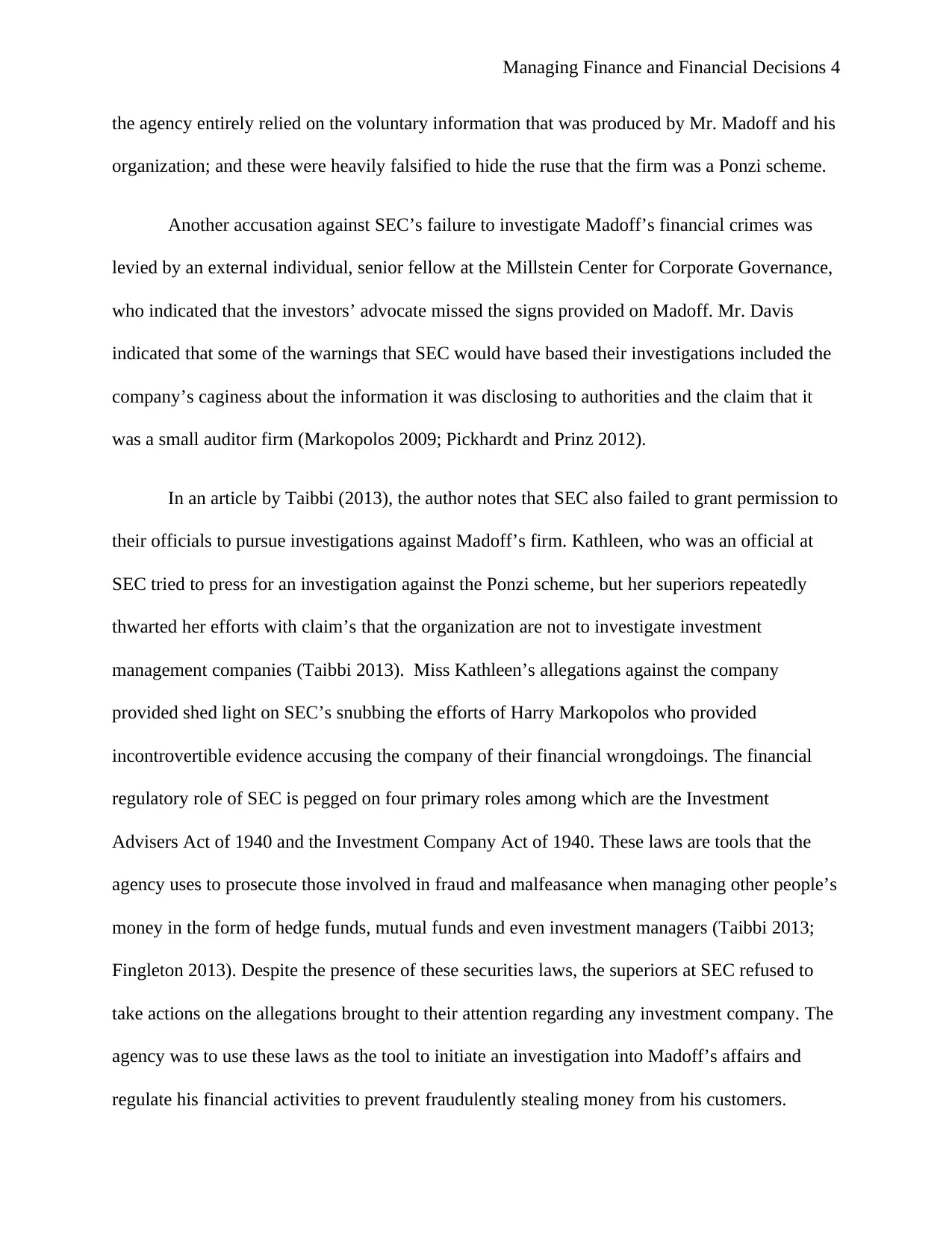
Managing Finance and Financial Decisions 4
the agency entirely relied on the voluntary information that was produced by Mr. Madoff and his
organization; and these were heavily falsified to hide the ruse that the firm was a Ponzi scheme.
Another accusation against SEC’s failure to investigate Madoff’s financial crimes was
levied by an external individual, senior fellow at the Millstein Center for Corporate Governance,
who indicated that the investors’ advocate missed the signs provided on Madoff. Mr. Davis
indicated that some of the warnings that SEC would have based their investigations included the
company’s caginess about the information it was disclosing to authorities and the claim that it
was a small auditor firm (Markopolos 2009; Pickhardt and Prinz 2012).
In an article by Taibbi (2013), the author notes that SEC also failed to grant permission to
their officials to pursue investigations against Madoff’s firm. Kathleen, who was an official at
SEC tried to press for an investigation against the Ponzi scheme, but her superiors repeatedly
thwarted her efforts with claim’s that the organization are not to investigate investment
management companies (Taibbi 2013). Miss Kathleen’s allegations against the company
provided shed light on SEC’s snubbing the efforts of Harry Markopolos who provided
incontrovertible evidence accusing the company of their financial wrongdoings. The financial
regulatory role of SEC is pegged on four primary roles among which are the Investment
Advisers Act of 1940 and the Investment Company Act of 1940. These laws are tools that the
agency uses to prosecute those involved in fraud and malfeasance when managing other people’s
money in the form of hedge funds, mutual funds and even investment managers (Taibbi 2013;
Fingleton 2013). Despite the presence of these securities laws, the superiors at SEC refused to
take actions on the allegations brought to their attention regarding any investment company. The
agency was to use these laws as the tool to initiate an investigation into Madoff’s affairs and
regulate his financial activities to prevent fraudulently stealing money from his customers.
the agency entirely relied on the voluntary information that was produced by Mr. Madoff and his
organization; and these were heavily falsified to hide the ruse that the firm was a Ponzi scheme.
Another accusation against SEC’s failure to investigate Madoff’s financial crimes was
levied by an external individual, senior fellow at the Millstein Center for Corporate Governance,
who indicated that the investors’ advocate missed the signs provided on Madoff. Mr. Davis
indicated that some of the warnings that SEC would have based their investigations included the
company’s caginess about the information it was disclosing to authorities and the claim that it
was a small auditor firm (Markopolos 2009; Pickhardt and Prinz 2012).
In an article by Taibbi (2013), the author notes that SEC also failed to grant permission to
their officials to pursue investigations against Madoff’s firm. Kathleen, who was an official at
SEC tried to press for an investigation against the Ponzi scheme, but her superiors repeatedly
thwarted her efforts with claim’s that the organization are not to investigate investment
management companies (Taibbi 2013). Miss Kathleen’s allegations against the company
provided shed light on SEC’s snubbing the efforts of Harry Markopolos who provided
incontrovertible evidence accusing the company of their financial wrongdoings. The financial
regulatory role of SEC is pegged on four primary roles among which are the Investment
Advisers Act of 1940 and the Investment Company Act of 1940. These laws are tools that the
agency uses to prosecute those involved in fraud and malfeasance when managing other people’s
money in the form of hedge funds, mutual funds and even investment managers (Taibbi 2013;
Fingleton 2013). Despite the presence of these securities laws, the superiors at SEC refused to
take actions on the allegations brought to their attention regarding any investment company. The
agency was to use these laws as the tool to initiate an investigation into Madoff’s affairs and
regulate his financial activities to prevent fraudulently stealing money from his customers.
Paraphrase This Document
Need a fresh take? Get an instant paraphrase of this document with our AI Paraphraser
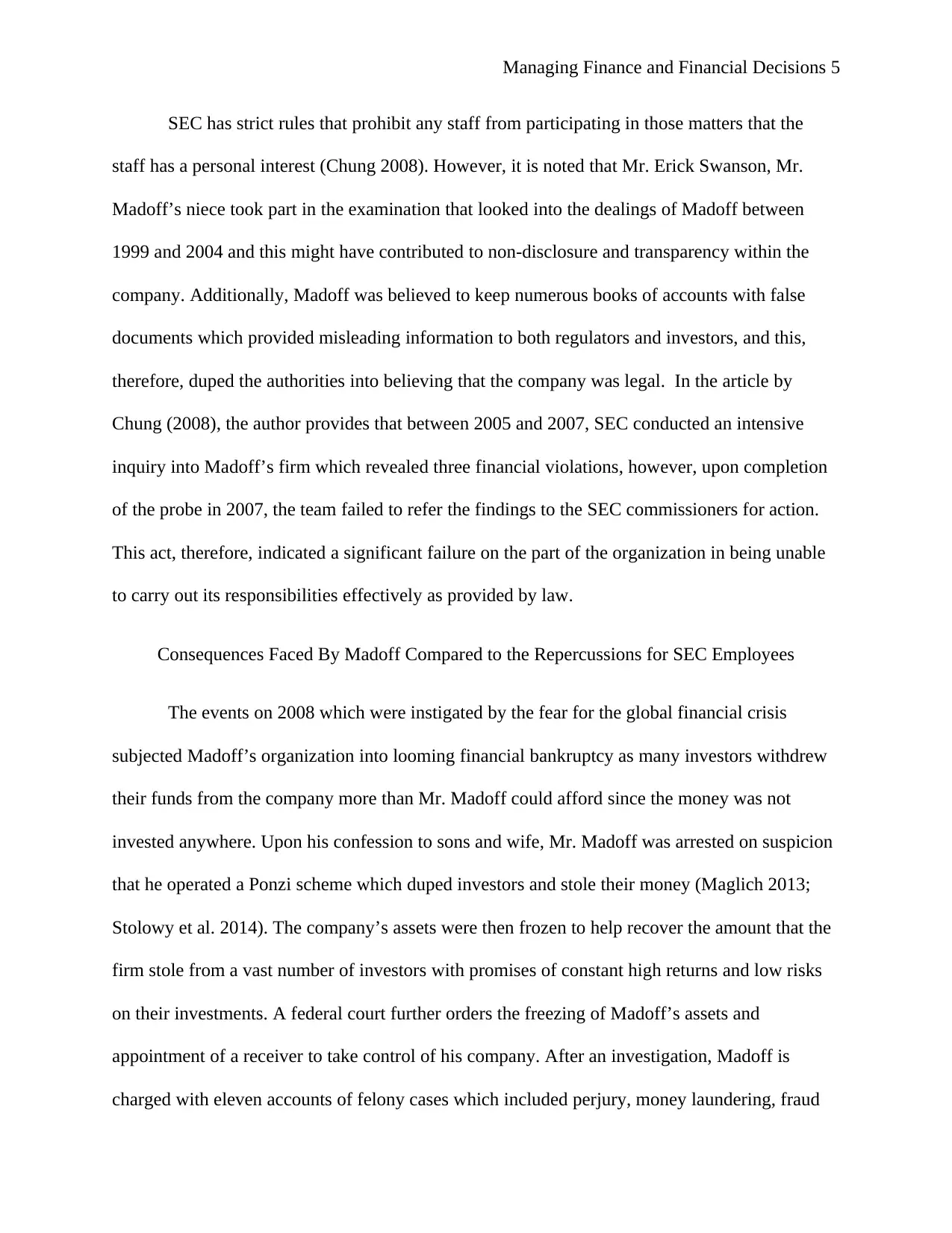
Managing Finance and Financial Decisions 5
SEC has strict rules that prohibit any staff from participating in those matters that the
staff has a personal interest (Chung 2008). However, it is noted that Mr. Erick Swanson, Mr.
Madoff’s niece took part in the examination that looked into the dealings of Madoff between
1999 and 2004 and this might have contributed to non-disclosure and transparency within the
company. Additionally, Madoff was believed to keep numerous books of accounts with false
documents which provided misleading information to both regulators and investors, and this,
therefore, duped the authorities into believing that the company was legal. In the article by
Chung (2008), the author provides that between 2005 and 2007, SEC conducted an intensive
inquiry into Madoff’s firm which revealed three financial violations, however, upon completion
of the probe in 2007, the team failed to refer the findings to the SEC commissioners for action.
This act, therefore, indicated a significant failure on the part of the organization in being unable
to carry out its responsibilities effectively as provided by law.
Consequences Faced By Madoff Compared to the Repercussions for SEC Employees
The events on 2008 which were instigated by the fear for the global financial crisis
subjected Madoff’s organization into looming financial bankruptcy as many investors withdrew
their funds from the company more than Mr. Madoff could afford since the money was not
invested anywhere. Upon his confession to sons and wife, Mr. Madoff was arrested on suspicion
that he operated a Ponzi scheme which duped investors and stole their money (Maglich 2013;
Stolowy et al. 2014). The company’s assets were then frozen to help recover the amount that the
firm stole from a vast number of investors with promises of constant high returns and low risks
on their investments. A federal court further orders the freezing of Madoff’s assets and
appointment of a receiver to take control of his company. After an investigation, Madoff is
charged with eleven accounts of felony cases which included perjury, money laundering, fraud
SEC has strict rules that prohibit any staff from participating in those matters that the
staff has a personal interest (Chung 2008). However, it is noted that Mr. Erick Swanson, Mr.
Madoff’s niece took part in the examination that looked into the dealings of Madoff between
1999 and 2004 and this might have contributed to non-disclosure and transparency within the
company. Additionally, Madoff was believed to keep numerous books of accounts with false
documents which provided misleading information to both regulators and investors, and this,
therefore, duped the authorities into believing that the company was legal. In the article by
Chung (2008), the author provides that between 2005 and 2007, SEC conducted an intensive
inquiry into Madoff’s firm which revealed three financial violations, however, upon completion
of the probe in 2007, the team failed to refer the findings to the SEC commissioners for action.
This act, therefore, indicated a significant failure on the part of the organization in being unable
to carry out its responsibilities effectively as provided by law.
Consequences Faced By Madoff Compared to the Repercussions for SEC Employees
The events on 2008 which were instigated by the fear for the global financial crisis
subjected Madoff’s organization into looming financial bankruptcy as many investors withdrew
their funds from the company more than Mr. Madoff could afford since the money was not
invested anywhere. Upon his confession to sons and wife, Mr. Madoff was arrested on suspicion
that he operated a Ponzi scheme which duped investors and stole their money (Maglich 2013;
Stolowy et al. 2014). The company’s assets were then frozen to help recover the amount that the
firm stole from a vast number of investors with promises of constant high returns and low risks
on their investments. A federal court further orders the freezing of Madoff’s assets and
appointment of a receiver to take control of his company. After an investigation, Madoff is
charged with eleven accounts of felony cases which included perjury, money laundering, fraud
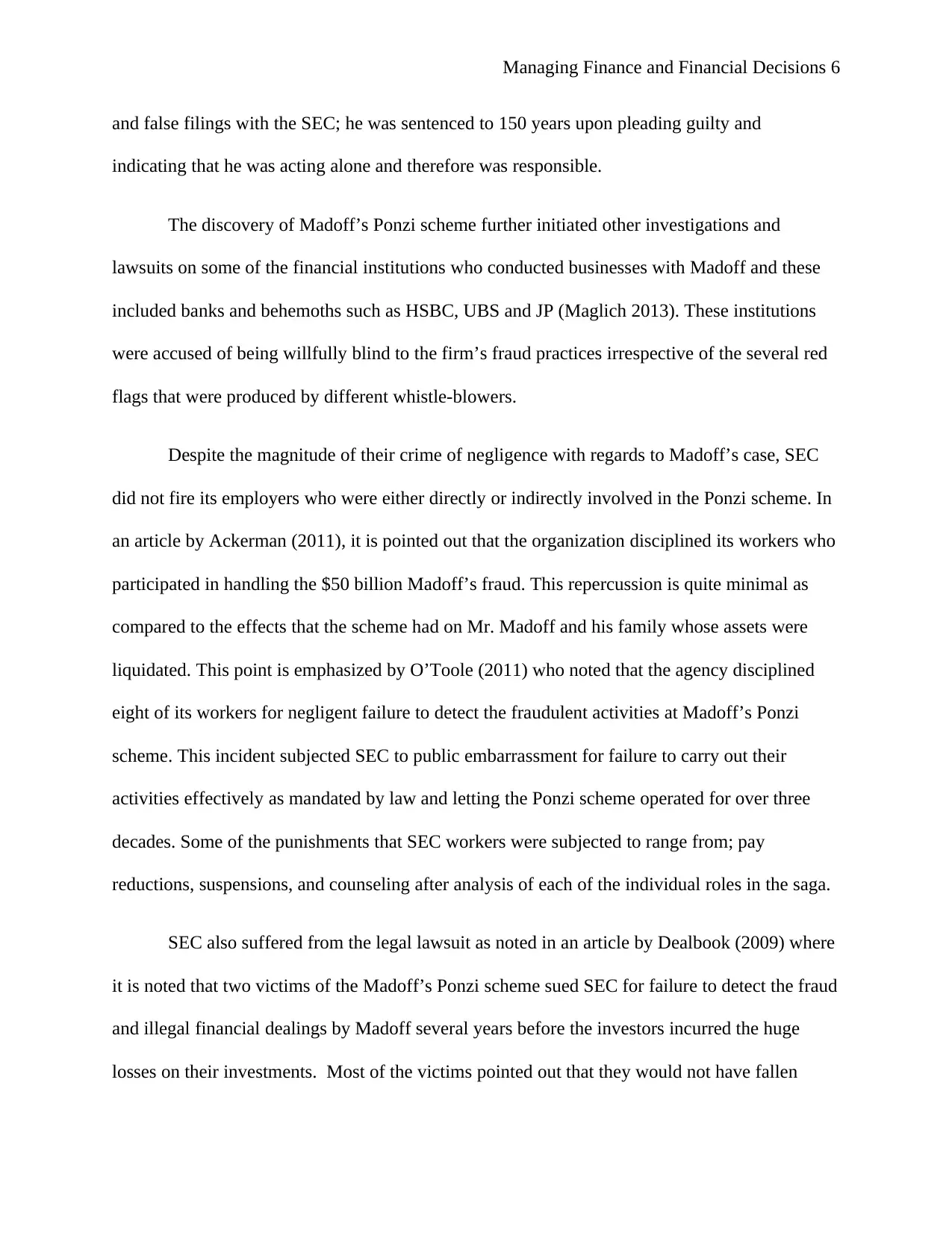
Managing Finance and Financial Decisions 6
and false filings with the SEC; he was sentenced to 150 years upon pleading guilty and
indicating that he was acting alone and therefore was responsible.
The discovery of Madoff’s Ponzi scheme further initiated other investigations and
lawsuits on some of the financial institutions who conducted businesses with Madoff and these
included banks and behemoths such as HSBC, UBS and JP (Maglich 2013). These institutions
were accused of being willfully blind to the firm’s fraud practices irrespective of the several red
flags that were produced by different whistle-blowers.
Despite the magnitude of their crime of negligence with regards to Madoff’s case, SEC
did not fire its employers who were either directly or indirectly involved in the Ponzi scheme. In
an article by Ackerman (2011), it is pointed out that the organization disciplined its workers who
participated in handling the $50 billion Madoff’s fraud. This repercussion is quite minimal as
compared to the effects that the scheme had on Mr. Madoff and his family whose assets were
liquidated. This point is emphasized by O’Toole (2011) who noted that the agency disciplined
eight of its workers for negligent failure to detect the fraudulent activities at Madoff’s Ponzi
scheme. This incident subjected SEC to public embarrassment for failure to carry out their
activities effectively as mandated by law and letting the Ponzi scheme operated for over three
decades. Some of the punishments that SEC workers were subjected to range from; pay
reductions, suspensions, and counseling after analysis of each of the individual roles in the saga.
SEC also suffered from the legal lawsuit as noted in an article by Dealbook (2009) where
it is noted that two victims of the Madoff’s Ponzi scheme sued SEC for failure to detect the fraud
and illegal financial dealings by Madoff several years before the investors incurred the huge
losses on their investments. Most of the victims pointed out that they would not have fallen
and false filings with the SEC; he was sentenced to 150 years upon pleading guilty and
indicating that he was acting alone and therefore was responsible.
The discovery of Madoff’s Ponzi scheme further initiated other investigations and
lawsuits on some of the financial institutions who conducted businesses with Madoff and these
included banks and behemoths such as HSBC, UBS and JP (Maglich 2013). These institutions
were accused of being willfully blind to the firm’s fraud practices irrespective of the several red
flags that were produced by different whistle-blowers.
Despite the magnitude of their crime of negligence with regards to Madoff’s case, SEC
did not fire its employers who were either directly or indirectly involved in the Ponzi scheme. In
an article by Ackerman (2011), it is pointed out that the organization disciplined its workers who
participated in handling the $50 billion Madoff’s fraud. This repercussion is quite minimal as
compared to the effects that the scheme had on Mr. Madoff and his family whose assets were
liquidated. This point is emphasized by O’Toole (2011) who noted that the agency disciplined
eight of its workers for negligent failure to detect the fraudulent activities at Madoff’s Ponzi
scheme. This incident subjected SEC to public embarrassment for failure to carry out their
activities effectively as mandated by law and letting the Ponzi scheme operated for over three
decades. Some of the punishments that SEC workers were subjected to range from; pay
reductions, suspensions, and counseling after analysis of each of the individual roles in the saga.
SEC also suffered from the legal lawsuit as noted in an article by Dealbook (2009) where
it is noted that two victims of the Madoff’s Ponzi scheme sued SEC for failure to detect the fraud
and illegal financial dealings by Madoff several years before the investors incurred the huge
losses on their investments. Most of the victims pointed out that they would not have fallen
⊘ This is a preview!⊘
Do you want full access?
Subscribe today to unlock all pages.

Trusted by 1+ million students worldwide
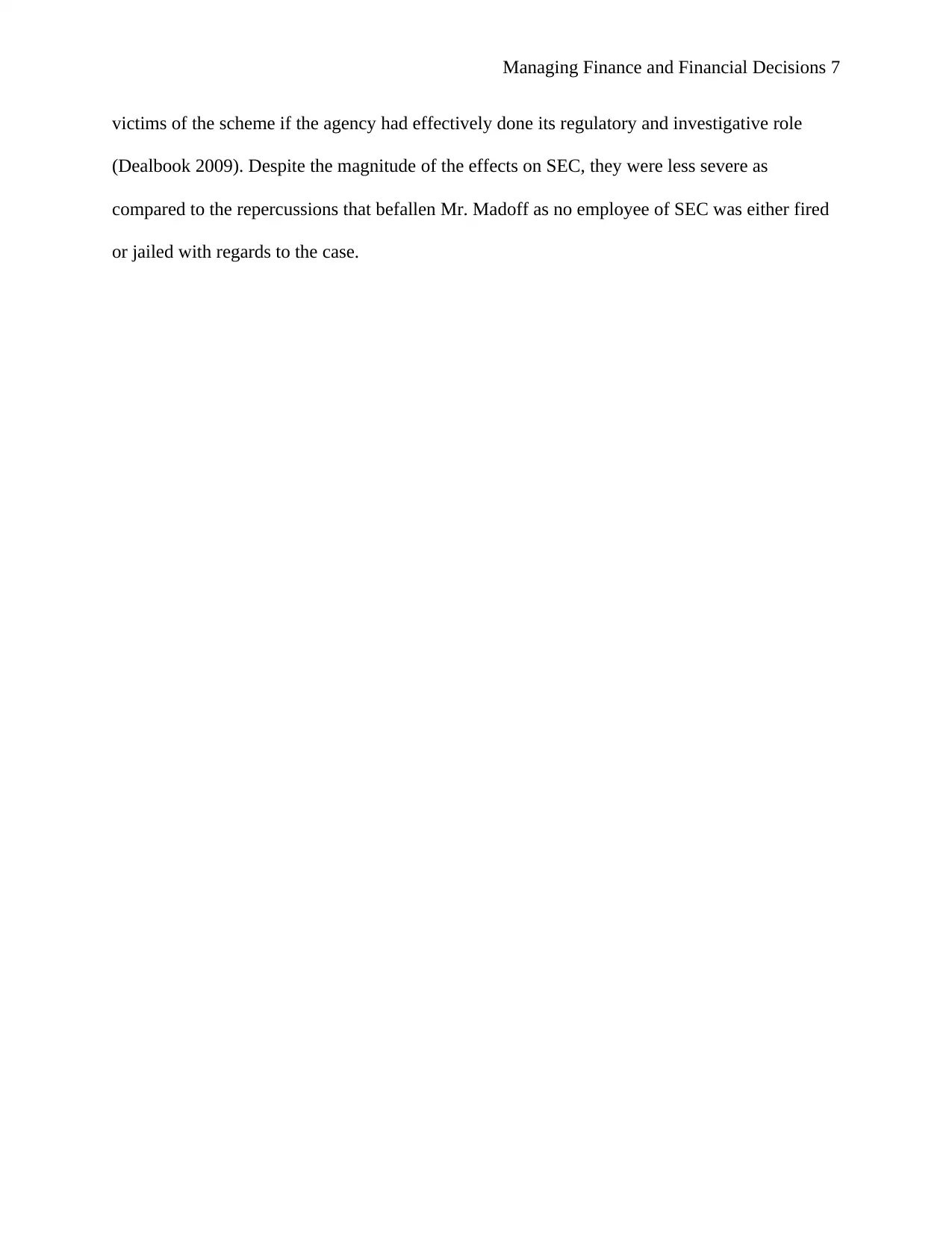
Managing Finance and Financial Decisions 7
victims of the scheme if the agency had effectively done its regulatory and investigative role
(Dealbook 2009). Despite the magnitude of the effects on SEC, they were less severe as
compared to the repercussions that befallen Mr. Madoff as no employee of SEC was either fired
or jailed with regards to the case.
victims of the scheme if the agency had effectively done its regulatory and investigative role
(Dealbook 2009). Despite the magnitude of the effects on SEC, they were less severe as
compared to the repercussions that befallen Mr. Madoff as no employee of SEC was either fired
or jailed with regards to the case.
Paraphrase This Document
Need a fresh take? Get an instant paraphrase of this document with our AI Paraphraser

Managing Finance and Financial Decisions 8
References
Ackerman, A., 2011. SEC Discipline Over Madoff. The Wall Street Journal.
https://www.wsj.com/articles/SB10001424052970204358004577032280966055886
(Accessed May 22, 2018).
Arvelund, E., 2009. Too Good to Be True: The Rise and Fall of Bernie Madoff. New York:
Portfolio.
Bernard, C. and Boyle, P.P., 2009. Mr. Madoff's amazing returns: An analysis of the split-strike
conversion strategy. Journal of Derivatives, 17 (1): pp. 62–76.
Campos, J.J., 2009. Avoiding the Discretionary Function Rule in the Madoff Case. Loy. L.
Rev., 55, p.587.
Chung, J., 2008. SEC chief admits to failures in Madoff case. Financial Times.
https://www.ft.com/content/92bd4c68-cbd7-11dd-ba02-000077b07658. (Accessed May
22, 2018).
Dealbook, 2009. S.E.C Sued Over Madoff Fraud. The Year York Times
https://dealbook.nytimes.com/2009/10/14/suit-accuses-sec-of-failing-to-detect-madoff-
scheme/ (Accessed May 22, 2018)
Fingleton, E., 2013. Madoff and the SEC: The story you don’t know. Forbes.
https://www.forbes.com/sites/eamonnfingleton/2013/06/04/heres-one-reason-why-east-
asians-think-america-is-a-basket-case/#41ffda6c29a7. (Accessed May 22, 2018).
Fisch, J.E., 2009. Top Cop or Regulatory Flop? The SEC at 75. Virginia Law Review, pp.785-
823.
Fishman, S., 2011. The Madoff Tapes. New York Magazine.
http://nymag.com/news/features/berniemadoff-2011-3/. (Accessed May 22, 2018).
Kirtzman, A., 2010. Betrayal: The life and lies of Bernie Madoff. Harper Collins.
References
Ackerman, A., 2011. SEC Discipline Over Madoff. The Wall Street Journal.
https://www.wsj.com/articles/SB10001424052970204358004577032280966055886
(Accessed May 22, 2018).
Arvelund, E., 2009. Too Good to Be True: The Rise and Fall of Bernie Madoff. New York:
Portfolio.
Bernard, C. and Boyle, P.P., 2009. Mr. Madoff's amazing returns: An analysis of the split-strike
conversion strategy. Journal of Derivatives, 17 (1): pp. 62–76.
Campos, J.J., 2009. Avoiding the Discretionary Function Rule in the Madoff Case. Loy. L.
Rev., 55, p.587.
Chung, J., 2008. SEC chief admits to failures in Madoff case. Financial Times.
https://www.ft.com/content/92bd4c68-cbd7-11dd-ba02-000077b07658. (Accessed May
22, 2018).
Dealbook, 2009. S.E.C Sued Over Madoff Fraud. The Year York Times
https://dealbook.nytimes.com/2009/10/14/suit-accuses-sec-of-failing-to-detect-madoff-
scheme/ (Accessed May 22, 2018)
Fingleton, E., 2013. Madoff and the SEC: The story you don’t know. Forbes.
https://www.forbes.com/sites/eamonnfingleton/2013/06/04/heres-one-reason-why-east-
asians-think-america-is-a-basket-case/#41ffda6c29a7. (Accessed May 22, 2018).
Fisch, J.E., 2009. Top Cop or Regulatory Flop? The SEC at 75. Virginia Law Review, pp.785-
823.
Fishman, S., 2011. The Madoff Tapes. New York Magazine.
http://nymag.com/news/features/berniemadoff-2011-3/. (Accessed May 22, 2018).
Kirtzman, A., 2010. Betrayal: The life and lies of Bernie Madoff. Harper Collins.
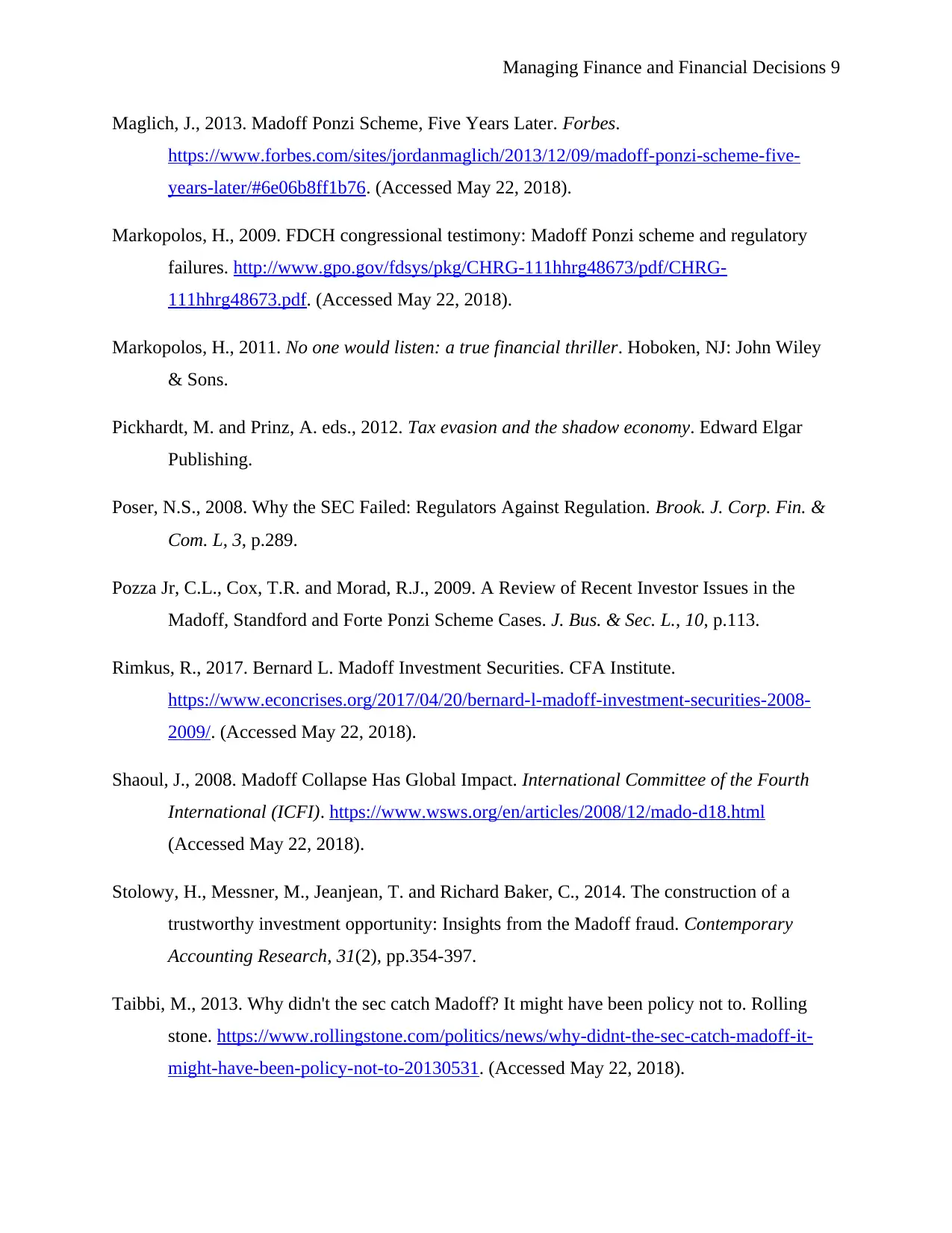
Managing Finance and Financial Decisions 9
Maglich, J., 2013. Madoff Ponzi Scheme, Five Years Later. Forbes.
https://www.forbes.com/sites/jordanmaglich/2013/12/09/madoff-ponzi-scheme-five-
years-later/#6e06b8ff1b76. (Accessed May 22, 2018).
Markopolos, H., 2009. FDCH congressional testimony: Madoff Ponzi scheme and regulatory
failures. http://www.gpo.gov/fdsys/pkg/CHRG-111hhrg48673/pdf/CHRG-
111hhrg48673.pdf. (Accessed May 22, 2018).
Markopolos, H., 2011. No one would listen: a true financial thriller. Hoboken, NJ: John Wiley
& Sons.
Pickhardt, M. and Prinz, A. eds., 2012. Tax evasion and the shadow economy. Edward Elgar
Publishing.
Poser, N.S., 2008. Why the SEC Failed: Regulators Against Regulation. Brook. J. Corp. Fin. &
Com. L, 3, p.289.
Pozza Jr, C.L., Cox, T.R. and Morad, R.J., 2009. A Review of Recent Investor Issues in the
Madoff, Standford and Forte Ponzi Scheme Cases. J. Bus. & Sec. L., 10, p.113.
Rimkus, R., 2017. Bernard L. Madoff Investment Securities. CFA Institute.
https://www.econcrises.org/2017/04/20/bernard-l-madoff-investment-securities-2008-
2009/. (Accessed May 22, 2018).
Shaoul, J., 2008. Madoff Collapse Has Global Impact. International Committee of the Fourth
International (ICFI). https://www.wsws.org/en/articles/2008/12/mado-d18.html
(Accessed May 22, 2018).
Stolowy, H., Messner, M., Jeanjean, T. and Richard Baker, C., 2014. The construction of a
trustworthy investment opportunity: Insights from the Madoff fraud. Contemporary
Accounting Research, 31(2), pp.354-397.
Taibbi, M., 2013. Why didn't the sec catch Madoff? It might have been policy not to. Rolling
stone. https://www.rollingstone.com/politics/news/why-didnt-the-sec-catch-madoff-it-
might-have-been-policy-not-to-20130531. (Accessed May 22, 2018).
Maglich, J., 2013. Madoff Ponzi Scheme, Five Years Later. Forbes.
https://www.forbes.com/sites/jordanmaglich/2013/12/09/madoff-ponzi-scheme-five-
years-later/#6e06b8ff1b76. (Accessed May 22, 2018).
Markopolos, H., 2009. FDCH congressional testimony: Madoff Ponzi scheme and regulatory
failures. http://www.gpo.gov/fdsys/pkg/CHRG-111hhrg48673/pdf/CHRG-
111hhrg48673.pdf. (Accessed May 22, 2018).
Markopolos, H., 2011. No one would listen: a true financial thriller. Hoboken, NJ: John Wiley
& Sons.
Pickhardt, M. and Prinz, A. eds., 2012. Tax evasion and the shadow economy. Edward Elgar
Publishing.
Poser, N.S., 2008. Why the SEC Failed: Regulators Against Regulation. Brook. J. Corp. Fin. &
Com. L, 3, p.289.
Pozza Jr, C.L., Cox, T.R. and Morad, R.J., 2009. A Review of Recent Investor Issues in the
Madoff, Standford and Forte Ponzi Scheme Cases. J. Bus. & Sec. L., 10, p.113.
Rimkus, R., 2017. Bernard L. Madoff Investment Securities. CFA Institute.
https://www.econcrises.org/2017/04/20/bernard-l-madoff-investment-securities-2008-
2009/. (Accessed May 22, 2018).
Shaoul, J., 2008. Madoff Collapse Has Global Impact. International Committee of the Fourth
International (ICFI). https://www.wsws.org/en/articles/2008/12/mado-d18.html
(Accessed May 22, 2018).
Stolowy, H., Messner, M., Jeanjean, T. and Richard Baker, C., 2014. The construction of a
trustworthy investment opportunity: Insights from the Madoff fraud. Contemporary
Accounting Research, 31(2), pp.354-397.
Taibbi, M., 2013. Why didn't the sec catch Madoff? It might have been policy not to. Rolling
stone. https://www.rollingstone.com/politics/news/why-didnt-the-sec-catch-madoff-it-
might-have-been-policy-not-to-20130531. (Accessed May 22, 2018).
⊘ This is a preview!⊘
Do you want full access?
Subscribe today to unlock all pages.

Trusted by 1+ million students worldwide

Managing Finance and Financial Decisions 10
US SEC., 2009. Investigation of failure of the sec to uncover Bernard Madoff’s Ponzi scheme,
public version. http://www.sec.gov/news/studies/2009/oig-509.pdf. (Accessed May 22,
2018).
US SEC., 2009. Investigation of failure of the sec to uncover Bernard Madoff’s Ponzi scheme,
public version. http://www.sec.gov/news/studies/2009/oig-509.pdf. (Accessed May 22,
2018).
1 out of 10
Related Documents
Your All-in-One AI-Powered Toolkit for Academic Success.
+13062052269
info@desklib.com
Available 24*7 on WhatsApp / Email
![[object Object]](/_next/static/media/star-bottom.7253800d.svg)
Unlock your academic potential
Copyright © 2020–2025 A2Z Services. All Rights Reserved. Developed and managed by ZUCOL.




![Madoff Investment Scandal: Finance Case Study at [University Name]](/_next/image/?url=https%3A%2F%2Fdesklib.com%2Fmedia%2Fimages%2Fmz%2F2765aa6c5a3d4bc588006e2ef92be27d.jpg&w=256&q=75)
